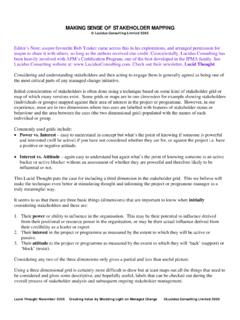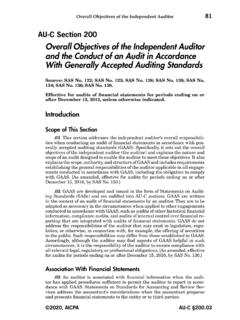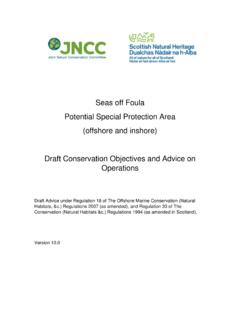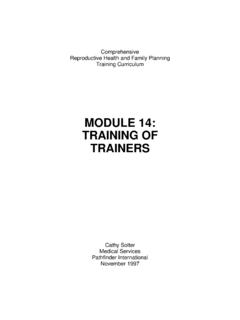Transcription of Defining The Hierarchy Of Project Objectives - IPMA-USA
1 2001 American Society for the Advancement of Project Management, and Robert Youker Defining The Hierarchy Of Project Objectives Linking Strategy and Projects: originally presented at an IPMA Conference in Slovenia, 1998 Robert Youker (retired), The World Bank , and Jerry Brown; revised 2001 Abstract Clear and concise Objectives early in the life cycle are critical to Project success because they help ensure that Project stakeholders will develop a: Common understanding of what the Project is attempting to do, and Commitment to the same Objectives . When this does not happen, the result is confu-sion and conflict as stakeholders gradually dis-cover differences in their interpretations of the Project s Objectives . It is important to get early agreement from all stakeholders that the Project Objectives are the ones that they want and that the enterprise needs.
2 A tool for achieving this is the Hierarchy of Project Objectives , which we describe in the following topics: Introduction Levels of Objectives Why-How Framework Strategic Alternatives Horizontal Logic Summary Conclusions References Introduction The methodology was developed as a means of clarifying Project Objectives , both for planning purposes and for post- Project evaluation. The Hierarchy of Objectives serves a number of pur-poses; namely it can be used to: 1. Clarify the need or demand for the Project . 2. Clarify the requirements for meeting the need. 3. Communicate the Project Objectives to eve-ryone involved in the Project . 4. Promote appropriate Project design by en-couraging feedback from the people who are involved in, or affected by, the Project .
3 5. Enable the post- Project evaluators to meas-ure the Project s success in attaining its objec-tives. The Hierarchy provides guidance to the evaluators and helps direct their inquiry. 6. Demonstrate that the Project has different levels of Objectives , and clarify how the ob-jectives relate to one another in the Hierarchy . 7. Visibly link a Project to the enterprise s busi-ness strategy. Studies that focus on Project success and failure support what many experts believe. Namely that the most important issue in Project man-agement is for the Project manager to get Project staff, beneficiaries, and other stakeholders to develop a common understanding, agreement, and commitment to a Project s Objectives . A shared perception about Objectives , agreement that the Project is worth doing, and the com-mitment to make it happen does not happen automatically.
4 It takes effort and involves a con-siderable amount of communication. Levels of Objectives The Hierarchy of Objectives is a tool that helps analyze and communicate a Project s Objectives . The Hierarchy of Objectives organizes the objec-tives of a Project into different levels of a hierar-chy or tree. Different organizations use different names for the various levels and the types of ob-jectives at each level. Otherwise, there is a great deal of similarity in approach. Our approach organizes Objectives into three broad levels: policy, strategic, and operational. In general, these levels correspond to the top, mid-dle, and working levels of management in an organization. Continued Defining the Hierarchy of Project Objectives /Youker, page 2 2001 American Society for the Advancement of Project Management, and Robert Youker Levels of Objectives , continued Broad, general Objectives (some people call them goals) that policymakers deal with, such as im-prove economic growth, fall into the top level and are called policy Objectives .
5 Objectives that are narrower in scope, such as increase literacy for teenage girls, fall into the mid-dle level and are called strategic Objectives . Objec-tives that relate directly to a Project s deliverables fall into the operational level and are called Project Objectives . Objectives that relate to Project inputs what is needed to make a pro-ject function are also considered operational and are called input Objectives . Operational objec-tives are usually the concern of working man-agement, including Project managers. Figure 1 Figure 1 shows an example of a Hierarchy of ob-jectives for an electric power plant. The hierar-chy has four types of Objectives : policy, strategic, Project , and input. They are grouped into three levels: policy, strategic, and operational.
6 Policy Objective. The overall policy objective is to increase industrial production. We then ask: How is this to be accomplished? That brings us to the next lower objective, the strategic objective. Strategic Objective: One way the country is trying to increase industrial production, the policy ob-jective, is by producing 50 KW of electric power. This is the strategic objective for the Project . Presumably there are other strategic Objectives and additional projects that support the overall policy objective. Again we ask: How is the 50 KW of electric power to be obtained? The answer takes us to the next lower level of objective in the Hierarchy : the Project objective. Project Objective: The Project objective in most cases is the same as the deliverable for the pro-ject.
7 In this case, it is to build a new power plant. Asking: How is the power plant to be built? again takes us to the next lower level of objec-tive, the input objective. Input Objective: The input Objectives relate pri-marily to the resources and conditions that are required to accomplish the Project . For the power Project , they consist of a $10 million con-tract, land for the power plant, and necessary labor and expertise. You may have noticed as we went down the hi-erarchy of Objectives that each time we asked how a particular objective was to be accom-plished, we went to the next lower level objec-tive for our answer. Why How Framework For example, if we ask: How is the 50 KW of power to be produced? The answer is at the next lower level and is the Project objective: Build a new power plant.
8 This illustrates an interesting and useful aspect of the Hierarchy of Objectives . Each level answers the how question for the level that is immediately above it in the Hierarchy . But the Hierarchy also has another interesting char-acteristic that we haven t mentioned yet, al-though you may have noticed it. This relates to what happens when you go up the Hierarchy . For example, Why build the power plant? (the Project objective.) Answer: To produce 50 KW of power (the strategic objective.) Continued Policy Objective Strategic Objective Project Objective Input Objective Increase Industrial Production Produce 50 KW Power New Power Plant $10 Million Contract, Land, Labor Defining the Hierarchy of Project Objectives /Youker, page 3 2001 American Society for the Advancement of Project Management, and Robert Youker Why How Framework, continued This feature of the Hierarchy of Objectives is called the Why-How framework.
9 The Why-How Framework is based on the Means-End Chain developed by March and Simon in 1958. When you ask why something is to be done you are asking about ends what is the purpose or objec-tive of the activity. When you ask how some-thing is to be done, you are asking about the means the strategy that will be used. Figure 2 As shown above in Figure 2, you answer Why questions by looking up the Hierarchy and How questions by going down the Hierarchy . This is true for every level in the Hierarchy . The next level up answers why the objective is being pur-sued. The next level down answers the question of how the objective is to be accomplished. This is very useful when developing a Why-How framework or Hierarchy of Objectives , be-cause it means that you can start anywhere in the Hierarchy at the top, bottom, or somewhere in the middle.
10 You simply work your way up and down from your starting place until you have developed a complete Hierarchy . Let s look at another example of how this works. You may be familiar with the age-old story about the stonemasons who were working on a cathedral. The first one when asked what he was doing said he was hitting stones with a hammer. The second one who was also hitting stones an-swered he was making square stones. The third stonecutter said he was building a wall, while the fourth said he was building a ca-thedral. The fifth one answered he was giving praise to the greater glory of God. Who was correct? The answer is that all of them were correct. Each was giving an objective that related to the Project , but which was at a different level in the Why-How Framework.










